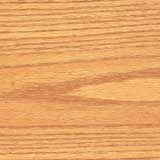|
The greater part of this country's Oak production, which is estimated to equal about one-third of the total production of all commercial hardwood lumber, consists of Red Oak and White Oak. Red Oak is produced in greater quantity than White Oak but all of its properties are not quite as good.
Some Red Oak is found in the Northeast and as far west as Minnesota, Wisconsin, and Iowa. The greatest volume of Red Oak lumber comes from the South, principally from the states of Alabama, Florida, Georgia, Kentucky, Louisiana, Mississippi, South Carolina, Tennessee and Texas. When sold commercially, Red Oak usually includes: Northern Red Oak, Southern Red Oak (also known as Scarlet Oak), Spanish Oak, Pin Oak, Laurel Oak, Shingle Oak-(also known as Northern Laurel Oak), Swamp Red Oak, Texan Oak (also known as Yellow Oak) and Willow Oak (also known as Pin Oak). Red Oak is also known in a few parts of the country as Turkey Oak but the name is not as common as those previously listed. Red Oak is very similar to White Oak in appearance and working characteristics, although the wood is not quite as strong. Its grain is more open than White Oak and slightly more obvious and its color is more generally red than brown. In the summerwood, the pores of Red Oak are relatively few and distinct enough to count but those of White Oak are very crowded and are usually too numerous to count. Although it is less resistant to decay than White Oak and is less waterproof because it has fewer tyloses than are present in White Oak, Red Oak varies so slightly in other favorable characteristics that it is generally used as an alternate for White Oak in less expensive constructions and wood products wherever darker pieces can be used. From a commercial standpoint there is little to choose between the two woods aside from color. Red Oak of the Water Oak and swamp grown species are quite often used in veneer form for containers, such as fruit crates, shingle boards and wire bound boxes, as well as for utility plywood. In the better grades, it is produced as rotary-cut, sliced or sawn veneer for face and decorative purposes. The natural color of Red Oak ranges from reddish brown to a decided reddish tinge, particularly near knots. Its color is warm, pleasant and its figure is especially attractive in novelty finish presentation. Red Oak is most abundant and is sufficiently hard, stiff, and strong to suit it for all types of wood construction. It is best adapted to constructions where some protection is afforded from the elements. It is especially well suited for flooring and interior finish as it has the degree of hardness required to resist indentation, high abrasive resistance, and an attractive grain and color. Red Oak appears in chairs and furniture. It is used in truck body parts, farming implements, boat and ship members and basketry. Red Oak is preferred for wagon parts, agricultural implements and machinery. It is used for doors, sash, millwork items, sewing machines, showcases, store fixtures, church furniture, car construction, aircraft industry parts, ladders, piano parts, elevator construction and many other items. Large quantities of Red Oak are also used in the lower grades for posts, poles, props and railroad ties. These items all require protective treatment before use to improve resistance to decay in contact with the soil. |

